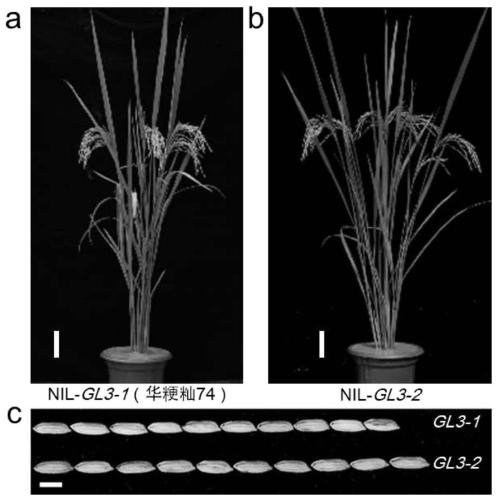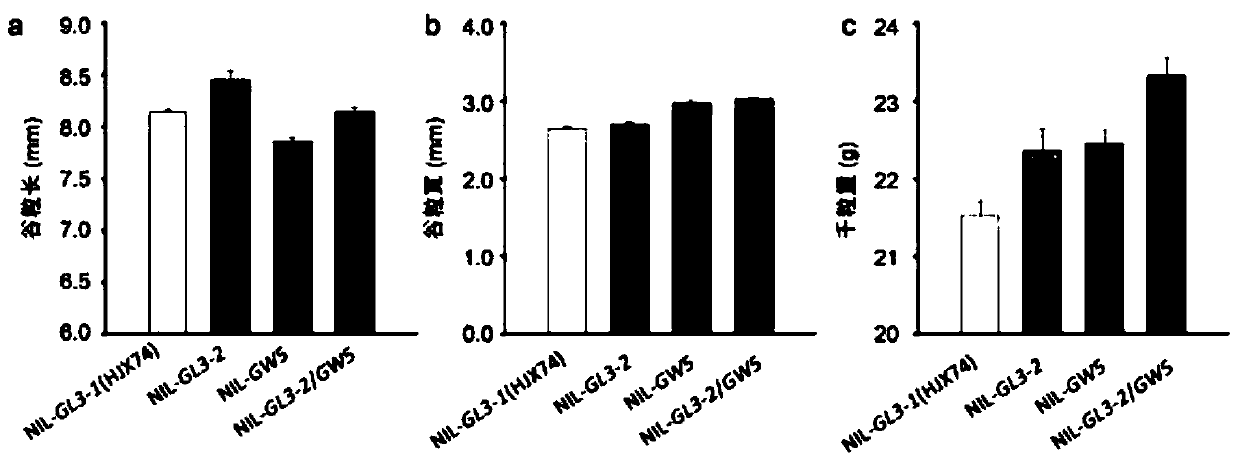Oryza sativa L. grain shape gene GL3 functional marker and application thereof
A molecular marker, GL3-FM technology, applied in the field of agricultural biology, can solve problems such as undeveloped molecular markers
- Summary
- Abstract
- Description
- Claims
- Application Information
AI Technical Summary
Problems solved by technology
Method used
Image
Examples
Embodiment 1
[0073] Example 1. Using Caps-labeled GL3-FM to assist selection to screen single-segment substitution materials carrying GL3-2 under the background of Huajing indica 74.
[0074] Specifically, using the rice variety Huajing Indica 74 as the recipient parent and Star bonnet 99 as the donor parent, a series of rice single-segment substitution line materials were constructed through conventional hybridization and backcrossing. With Huajaponica indica 74 as the female parent and Star bonnet 99 as the male parent, conventional crosses were carried out to obtain F 1 Substitute hybrids, which yield F after selfing homozygous 2 Substitute material, and then on the obtained F 2 Substitute material randomly selected a single plant to use Huajing indica 74 backcross, after at least 3 consecutive backcrosses, self-homozygous. Molecular marker-assisted selection was used for the obtained homozygous materials to determine the chromosome fragments from Star bonnet 99 carried in different i...
Embodiment 2
[0091] Example 2. Identification of rice germplasm resources carrying GL3-2 using molecular marker GL3-FM
[0092] The specific method is: randomly select rice germplasm resources from many countries and regions in the world, extract leaf genomic DNA, and use GL3-FM to identify the allele types of these genetic materials.
[0093] 1. DNA extraction
[0094] Same as Example 1.
[0095] 2. PCR amplification
[0096] Same as Example 1.
[0097] 3. Restriction system of PCR amplification products
[0098] Same as Example 1.
[0099] 4. Detection by agarose gel electrophoresis
[0100] Same as Example 1.
[0101] according to figure 2 , the following conclusions can be drawn: GL3-FM can be used to identify GL3-FM allele types in different rice materials. as figure 2 As shown in the electrophoresis results, the material with only one band carries the GL3-1 allele, and the band pattern is read as "1"; the material with two bands carries the GL3-2 allele, and the band patte...
Embodiment 3
[0107] Example 3. Using molecular marker GL3-FM to carry out assisted selection of granule gene and construction of aggregation line
[0108] Using the constructed, Huajing Indica 74 background, the GW5 allele comes from a single-segment material (named NIL-GW5) of the large-grain rice variety Su Yunuo, which uses the large-grain rice variety Su Yunuo as the donor parent. It was crossed with Huajing Indica 74, and a single plant was selected for continuous backcrossing with Huajing Indica 74 for at least 4 generations in the progeny, and finally it was homozygous for self-crossing. The obtained materials were screened using GW5-specific markers to obtain NIL-GW5. Compared with Huajing Indica 74, the grain shape of NIL-GW5 decreased in rice grain length, but increased significantly in grain width.
[0109] Citation by GW5: Shomura A, et al. Deletion in a gene associated with grainsize increased yields during rice domestication. Nat Genet, 2008, 40: 1023-1028 (Shomura A, et al....
PUM
 Login to View More
Login to View More Abstract
Description
Claims
Application Information
 Login to View More
Login to View More - R&D
- Intellectual Property
- Life Sciences
- Materials
- Tech Scout
- Unparalleled Data Quality
- Higher Quality Content
- 60% Fewer Hallucinations
Browse by: Latest US Patents, China's latest patents, Technical Efficacy Thesaurus, Application Domain, Technology Topic, Popular Technical Reports.
© 2025 PatSnap. All rights reserved.Legal|Privacy policy|Modern Slavery Act Transparency Statement|Sitemap|About US| Contact US: help@patsnap.com



